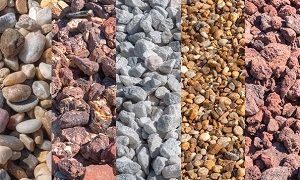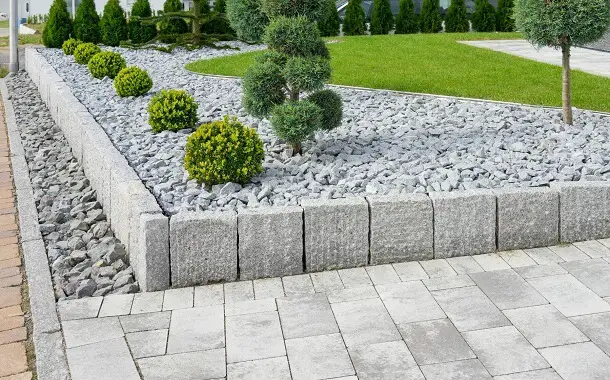Landscaping Rocks Cost
Landscaping a garden with rocks is not a difficult task and can have spectacular and lasting results. You can choose between a wide variety of rocks, from artificial to large ones which are brought in by a crane.
How Much Do Landscaping Rocks Cost?
The cost of landscaping rocks depends on several factors such as the type of rocks, their size, the quantity, and the company you buy them from. The majority of the landscaping supply companies are charging by square footage or by the ton. As there are so many types of rocks, depending on the type of the rock, the costs may vary from $35 to $70 per cubic foot or $35 to $110 per ton.
However, the cost of large landscaping rocks like boulders will be around $820 per ton. For instance, an Arctic white boulder costs around $160 per ton, while a volcanic rock costs almost $620 per ton.
The price of a single boulder that measures 16”x26”x36” is anywhere between $160 and $310, while for a boulder that is 28”x36”x44” you will have to pay $300 to $460.
The price of a natural rock step would be anywhere between $85 and $210.
You might also like our articles about the cost of decomposed granite, crushed stone delivery, or crushed limestone.
The natural stone edging is ideal for walkways and gardens and costs anywhere between $210 and $610 per ton.
The price of faux landscaping rocks may cost $50 to $110 or even more just for one rock that can stand one to two feet high.
Expect to pay anywhere between $5 and $7 for a small bag of rocks like pea gravel or lave rocks. You can purchase these bags from retailers like Lowe’s and Home Depot. A bag will be enough to cover 0.5 cubic feet. If you were to buy in bulk, you will have to pay anywhere between $35 and $60 per cubic foot.
Also, for a bag of decorative landscaping rocks, like Bryan red rock or river rock, which is enough to cover 0.5 cubic feet, you will have to pay $6 to $10. Depending on the variety, for the larger loads, you will have to get anywhere between $210 and $620 per ton or $55 to $70 per cubic foot out of your pocket.
The cost of Mexican beach pebbles is up to $720 per ton or $25 to $50 per pound.
Expect to pay $35 to $60 per cubic foot for decomposed granite, while crushed granite costs anywhere between $65 and $80 per yard.
Landscaping rocks details
The common sizes of smaller landscaping rocks include one inch, ½”, ¼”, ¾”, and 2/8”.
There are some categories of landscaping rock such as rip rap, landscape rock, sand, boulders, and river rock.
If a certain price is met for the smaller rocks, many local landscaping companies and local nurseries may deliver them right to your doorstep.
Types of landscape rocks
- River rocks can be found at the majority of big-name hardware stores. These are used when the water has to be drained and run off to a certain point in the yard. These rocks are a little bit larger than the pea gravel.
- Boulders can be surrounded by ornamental grass or stand on their own in the yard.
- Pea gravel comes in many sizes and colors, but the average size is that of a pea. This can be used as a filler or as a simple walkway surface.
- Crushed granite is larger and chunkier than decomposed granite and can come in beige and red colors.
- Mexican beach pebbles will offer your yard a tropical look. These are smooth, polished, and have a grayish-black color. It can be hard to find in certain areas of the United States.
- Decomposed granite looks more like dirt from a distance, but in general, it can be red or tan in color. The size of this rock is small and can be used to replace areas that may use concrete or asphalt, such as driveways. Also, it is cheap and readily available.
- Lava rock is red or black and mined from volcanic lava domes. This rock comes in many sizes and can be used for walkways, as an accent piece, or as ground cover.
- Flagstone is a flat piece of stone used in general as a walkway.
What are the extra costs?
In case you don’t meet a minimum, the majority of the landscaping rock companies will charge a delivery fee, which is more than $55.
Also, if you would like to wrap the rock in plastic during transportation you will have to pay anywhere between $9 and $40 per rock.
Landscaping rocks can be non-screened or screened. The costs may be 40% more than the rocks that are screened.
Before installing the rock, you should install a tough, black fabric screen to prevent the weeds from popping through the rocks and allow water to flow through them.
Important things to consider
 First of all, it is important to decide the area where the landscaping rocks will be located. The ideal option would be on a slope in the sun or partially shaded. If your garden is flat, the ornamental rocks will give it an extra personality, as long as you do not add too many, risking turning your space into a much too crowded one.
First of all, it is important to decide the area where the landscaping rocks will be located. The ideal option would be on a slope in the sun or partially shaded. If your garden is flat, the ornamental rocks will give it an extra personality, as long as you do not add too many, risking turning your space into a much too crowded one.
It is also essential to remember that ornamental rocks will create a spectacular visual effect if you place them near a water source – stream, pond, etc. – as well as along the walls. Placing rocks under trees is not a recommended option, as you will only be able to choose shade-loving “alpine” plants. In addition, the fall of the leaves risks suffocating your plants located among the rocks, when autumn comes.
If you want your garden to look as natural as possible, use rocks of various shapes, just as they are found in nature. Instead, for a modern, symmetrical garden, choose ornamental rocks of similar size and possibly polished so that their shape is similar (rounded stones create a special visual effect).
Finally, do not hesitate to turn to a landscaping company or a landscaper to help you design a garden landscaping plan with ornamental rocks, in case you are not satisfied with your own ideas.
How can I save money?
Make sure you get price offers from at least three companies before choosing the one that is right for you and your budget.
Take into consideration looking for rocks at the local landfills. If you are lucky enough you may be able to find larger rocks in these landfills.


Leave a Reply
Want to join the discussion?Feel free to contribute!